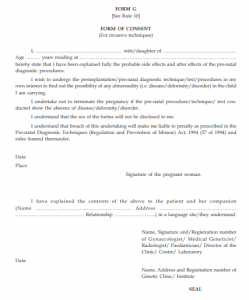The law allows the use of prenatal diagnostic procedures in certain limited circumstances.
Prenatal diagnostic procedures can be conducted to detect chromosomal abnormalities, genetic metabolic diseases, haemoglobinopathies, sex-linked genetic diseases, congenital anomalies, and other abnormalities or diseases in the foetus.(( Section 4(2), Pre-conception and Pre-natal Diagnostic Techniques (Prohibition of Sex Selection) Act, 1994.))
To conduct such procedures to detect the above abnormalities, the written consent of the pregnant woman must be taken,(( Rule 10, Pre-Conception and Pre-Natal Diagnostic Techniques (Prohibition of Sex Selection) Rules, 1996.)) and at least one of the following conditions(( Section 4(3), Pre-conception and Pre-natal Diagnostic Techniques (Prohibition of Sex Selection) Act, 1994.)) must also be applicable. To conduct such procedures, it is necessary that:
- The pregnant woman is older than 35 years;
- The pregnant woman has had two or more spontaneous abortions or foetal loss;
- The pregnant woman has been exposed to potentially teratogenic agents such as drugs, radiation, infection or chemicals;
- The pregnant woman or her spouse has a family history of mental retardation or physical deformities.
If a prenatal diagnostic procedure is conducted after meeting these conditions, the person conducting ultrasonography on the pregnant woman must keep a complete record of it in the clinic as provided under the law.(( Section 4, Pre-conception and Pre-natal Diagnostic Techniques (Prohibition of Sex Selection) Act, 1994)).

